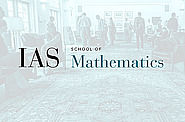2005-2006 seminars
Mar
28
2006
Computer Science/Discrete Mathematics Seminar II
The Grothendieck Constant of an Expander
10:30am|S-101
Mar
27
2006
Computer Science/Discrete Mathematics Seminar I
The Cover Time of Random Walks on Random Graphs
Alan Frieze
11:15am|S-101
Mar
21
2006
Lie Groups, Representations and Discrete Mathematics
Cartesian Products as Profinite Completions and Representation Growth of Groups
4:00pm|S-101
Mar
21
2006
Lie Groups, Representations and Discrete Mathematics
Linear Representations of the Automorphism Group of a Free Group
2:10pm|S-101
Mar
21
2006
Lie Groups, Representations and Discrete Mathematics
Kazhdan's Property (T) for Linear Groups Over General Rings
11:30am|S-101
Mar
21
2006
Lie Groups, Representations and Discrete Mathematics
Golod-Shafarevich Groups with Property (T) and Kac-Moody Groups
10:15am|S-101
Mar
20
2006
Mar
16
2006
Computer Science/Discrete Mathematics Seminar III
Time-Space Trade-Offs for Predecessor Search
Mikkel Thorup
11:15am|S-101
Mar
14
2006
Computer Science/Discrete Mathematics Seminar II
Group Theoretic Algorithms For Fast matrix Multiplication
Balazs Szedgedy
10:30am|S-101
Mar
13
2006
Computer Science/Discrete Mathematics Seminar I
On the (Im)possibility of Basing One-Way Functions on NP-Hardness
11:15am|S-101
